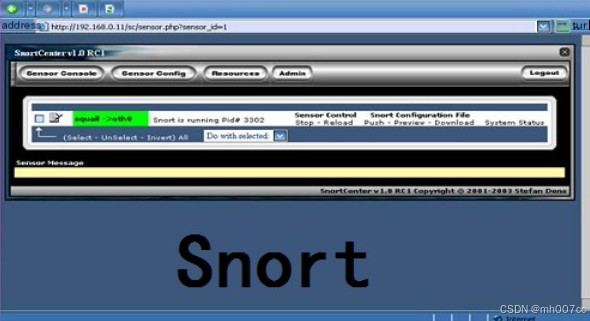In today’s digital society, cybersecurity issues are becoming increasingly prominent. To effectively defend against cyberattacks, deploying an Intrusion Detection System (IDS) is a necessary protective measure. Snort, as a powerful open-source IDS tool, is widely used in various network environments. This article will guide you step by step to build a Snort intrusion detection system from scratch.
What is Snort?
Snort is an open-source network intrusion detection and prevention system (IDS/IPS) capable of real-time network traffic analysis to detect and respond to various cyberattacks. Snort uses predefined rule sets to detect anomalies and known attacks and generates detailed alerts and logs.

Environment Preparation
Before installing Snort, you need to prepare a suitable operating system and the necessary software dependencies. It is recommended to use Ubuntu or CentOS for deployment.
1. Install Required Libraries
First, ensure that the necessary libraries are installed on your system. Open the terminal and execute the following commands:
# Update system packages
sudo apt-get update
sudo apt-get upgrade
# Install necessary libraries
sudo apt-get install -y build-essential libpcap-dev libpcre3-dev libdnet-dev zlib1g-dev
# Install DAQ (Data Acquisition Library)
wget https://www.snort.org/downloads/snort/daq-2.0.7.tar.gz
tar -xvzf daq-2.0.7.tar.gz
cd daq-2.0.7
./configure && make && sudo make install
# Install Libpcap
sudo apt-get install libpcap-dev
# Install Flex
sudo apt-get install flex
# Install Bison
sudo apt-get install bison2. Download and Install Snort
Download the latest version of Snort from the official website and install it:
# Download Snort
wget https://www.snort.org/downloads/snort/snort-2.9.15.tar.gz
tar -xvzf snort-2.9.15.tar.gz
cd snort-2.9.15
# Configure and compile Snort
./configure --enable-sourcefire
make
sudo make install
# Create necessary directories for Snort
sudo mkdir /etc/snort
sudo mkdir /etc/snort/rules
sudo mkdir /etc/snort/preproc_rules
sudo mkdir /var/log/snort
sudo mkdir /usr/local/lib/snort_dynamicrules3. Configure Snort
Download the rule set and configure Snort:
# Download Snort rule set
wget https://www.snort.org/rules/snortrules-snapshot-29150.tar.gz
tar -xvzf snortrules-snapshot-29150.tar.gz -C /etc/snort/rules
# Edit the main configuration file
sudo nano /etc/snort/snort.conf
# Configure network variables and rule paths in snort.conf
# Example network variables:
# var HOME_NET [192.168.1.0/24]
# var EXTERNAL_NET !$HOME_NET
# Specify rule paths
# include $RULE_PATH/local.rules
# include $RULE_PATH/community.rules
# include $RULE_PATH/emerging.rules4. Start Snort
After configuration is complete, you can start Snort for real-time traffic monitoring using the following command:
# Start Snort
sudo snort -A console -q -c /etc/snort/snort.conf -i eth0-A console: Outputs alerts to the console.-q: Quiet mode, reduces console output.-c: Specifies the configuration file path.-i: Specifies the network interface to monitor.
Configuring and Using Snort Rules
Snort detects network anomalies and attacks through rules. You can use official rules, community rules, or create custom rules.
1. Official Rules
The official rule sets can be downloaded from the Snort website. Registration and login are required to access:
After downloading, extract the rules into the designated directory:
tar -xvzf snortrules-snapshot-29150.tar.gz -C /etc/snort/rules2. Custom Rules
You can create custom rules based on specific needs. For example, detect access to a specific port:
# Edit the local.rules file
sudo nano /etc/snort/rules/local.rules
# Add a custom rule
alert tcp any any -> any 80 (msg:"HTTP Connection Detected"; sid:1000001; rev:1;)Logs and Alert Handling
When Snort detects anomalous activities, it generates logs and alerts. You can analyze these to investigate security incidents in the network.
1. Log Storage
By default, Snort stores logs in the /var/log/snort directory. Use the following command to view logs:
cat /var/log/snort/alert2. Alert Handling
Snort can send alerts via various channels, including email and syslog. To configure alert handling, edit the relevant sections in the snort.conf file.
Maintenance and Updates
To ensure Snort effectively detects the latest threats, regular updates of the rule sets and Snort version are necessary.
1. Updating Rule Sets
You can use the PulledPork tool to automate Snort rule updates:
# Install PulledPork
git clone https://github.com/shirkdog/pulledpork.git
cd pulledpork
sudo cp pulledpork.pl /usr/local/bin
# Configure PulledPork
sudo nano /etc/snort/pulledpork.conf
# Run PulledPork to update rules
sudo pulledpork.pl -c /etc/snort/pulledpork.conf -vv2. Updating Snort Version
Regularly visit the Snort official website to download and install the latest version of Snort, ensuring the system has the latest features and security enhancements.
Conclusion
Cybersecurity is a field full of challenges and opportunities. By implementing and applying a Snort intrusion detection system, you can enhance your technical expertise and contribute to the cybersecurity industry. We warmly invite students and businesses to join us in research and development, exploring the mysteries of cybersecurity and safeguarding the future of network security.


